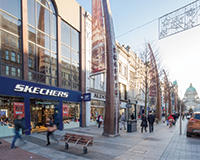With the new draft rating list due next week, Jonathan Cole hopes the government will learn from Northern Ireland’s example so retail can reap the rewards of revaluation
The delayed 2017 rates revaluation is now just over six months away, and – much like Brexit – many businesses are still wondering what effect it will have on them.
Amid all the uncertainty, one thing is certain: the vote for Brexit will bring all aspects of UK competitive advantage under the microscope. Worryingly then, the UK has by far the highest business rates burden in Europe (three times that of France, and five times that of Germany, as a percentage of GDP).
This burden has continued to grow, well in excess of other taxes: between 2007 and 2015, revenue from business rates increased by 28%, according to the CBI, 50% higher than the growth in overall tax revenue. If the economics of bricks and mortar were not already creaking under this fiscal weight, from April 2017 the tax deductibility of debt is to be reduced under base erosion and profit shifting (BEPS) rules, further denting the attraction of capital investment in commercial property.
The Northern Ireland experience
Against this backdrop, the 2017 rates revaluation should go some way towards rebalancing rates liability between the South East and the rest of the UK. The effect of the delay to the revaluation has been most keenly felt in regional retail, where 2008 rental values have continued to dictate rates liabilities for a further two years, despite rents having been rebased by an average of 36% since the financial crisis. This provides potential for a welcome boost to town centres, which – despite shouldering more than their fair share of rates in recent years – remain the commercial and social heart of their communities.
There is hard evidence from Northern Ireland of what this boost might look like. Northern Ireland was the only part of the UK not to delay its rates revaluation, which took effect in April 2015. The results have been quite startling.
Unlike in England, “transitional relief” has not been applied in Northern Ireland, meaning rates payable in some retail locations were allowed to halve overnight, finally falling back into line with the rents being paid by most tenants. The effect of lower occupational costs has been reduced retail void rates and increased economic activity.
In central Belfast, for example, rates liabilities for retail units have dropped by up to 55%, which contributed to a “notable increase” in occupational demand, according to local experts Lisney. Belfast vacancy rates fell from 19.8% to 12.5% between 2014 and 2015, with a further reduction expected in 2016. By comparison, the British Council of Shopping Centres reported that shop vacancy rates for the rest of the UK, where rates were not changed, reduced only marginally, from 13.3% to 12.5% over the same period. As the all-important total occupational cost of retail units is reduced, and a link is re-established between demand and market pricing, then entrepreneurship takes effect and place-making begins.
Reduced rates are a catalyst for change
More new retail brands have been attracted to Belfast since the rates revaluation than at any point since the recession, from aspirational brands such as Michael Kors and Jaeger through to value offerings such as Tiger and Yours. Existing operators have committed to new sites, creating a more vibrant retail and leisure experience for shoppers. Having fewer empty shops creates a multiplier effect for surrounding businesses, who benefit from improved footfall – and in turn they too help to boost the local economy. As a result, further capital investment is attracted to a city going from strength to strength.
At Ellandi, we focus on community shopping centres, where the same positive effect can be observed. We purchased two dominant community schemes in Northern Ireland during 2015, just as rates reductions of up to 30% took effect. In conjunction with a pro-active investment and management philosophy, the rates reduction has helped to retain existing retailers and to attract new operators to fill voids. The result is ultimately better amenities for the communities these schemes serve, in Enniskillen and Bangor, as well as more jobs for local people. There is also a reinvigorated sense of civic pride as new retailers arrive and the “town square” is transformed into something better.
Will the government pay heed?
The Northern Irish example reminds us that business rates have an opportunity cost: the multiplier effect of income and capital investment that has been diverted to paying the tax, or has been made unviable by the level of rates charged. Getting the balance right can be tangible and transformative.
Whether the government will take note of Northern Ireland’s revaluation, and levy affordable rates with immediate effect by abolishing downward transitional relief, remains to be seen.
We at Ellandi certainly hope to see our other 27 shopping centres, from St Austell to Falkirk, benefit from what we have seen across the Irish Sea. However, like everyone else on this subject – and Brexit – we’re still in the dark.
Jonathan Cole is acquisitions manager at shopping centre investor Ellandi









